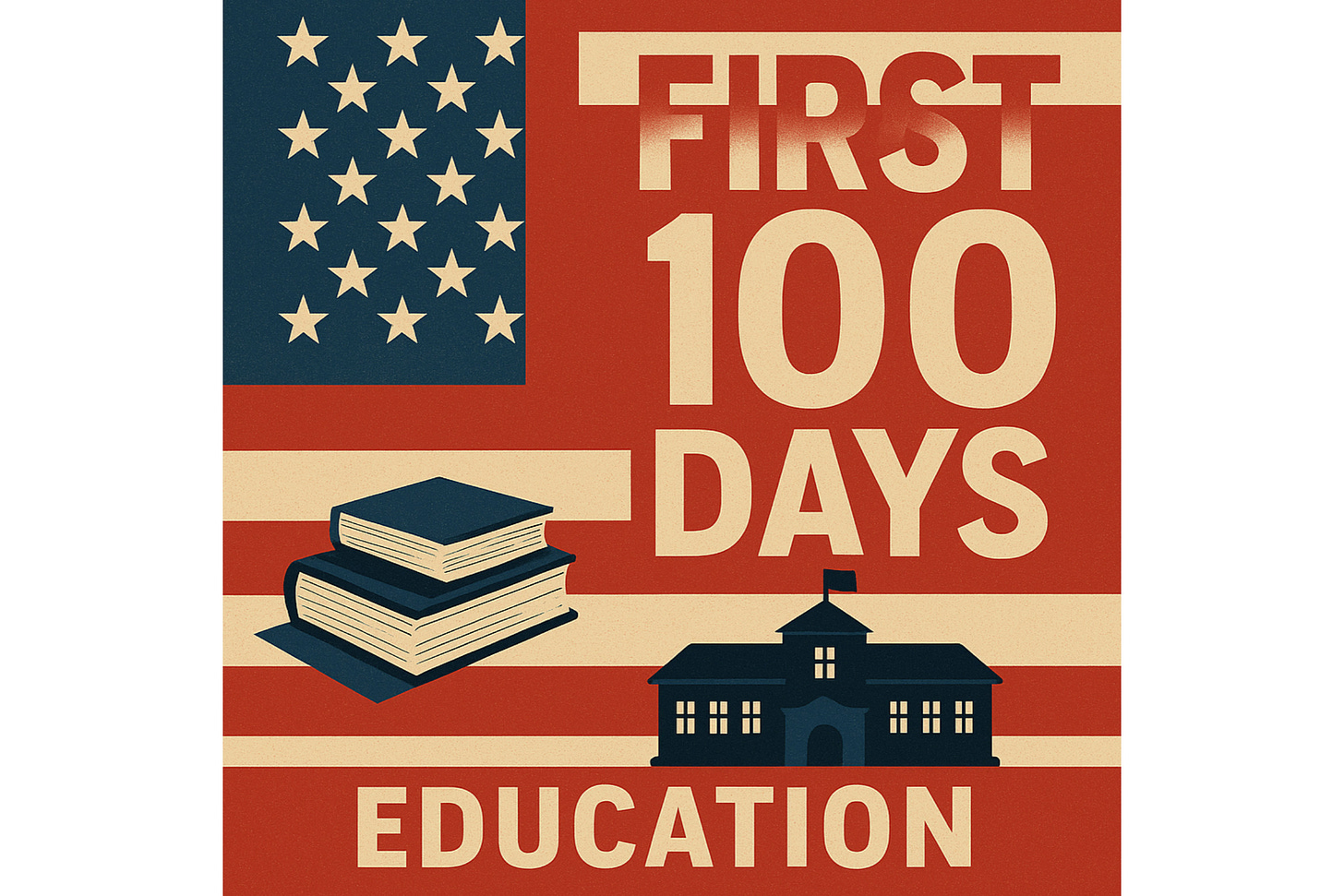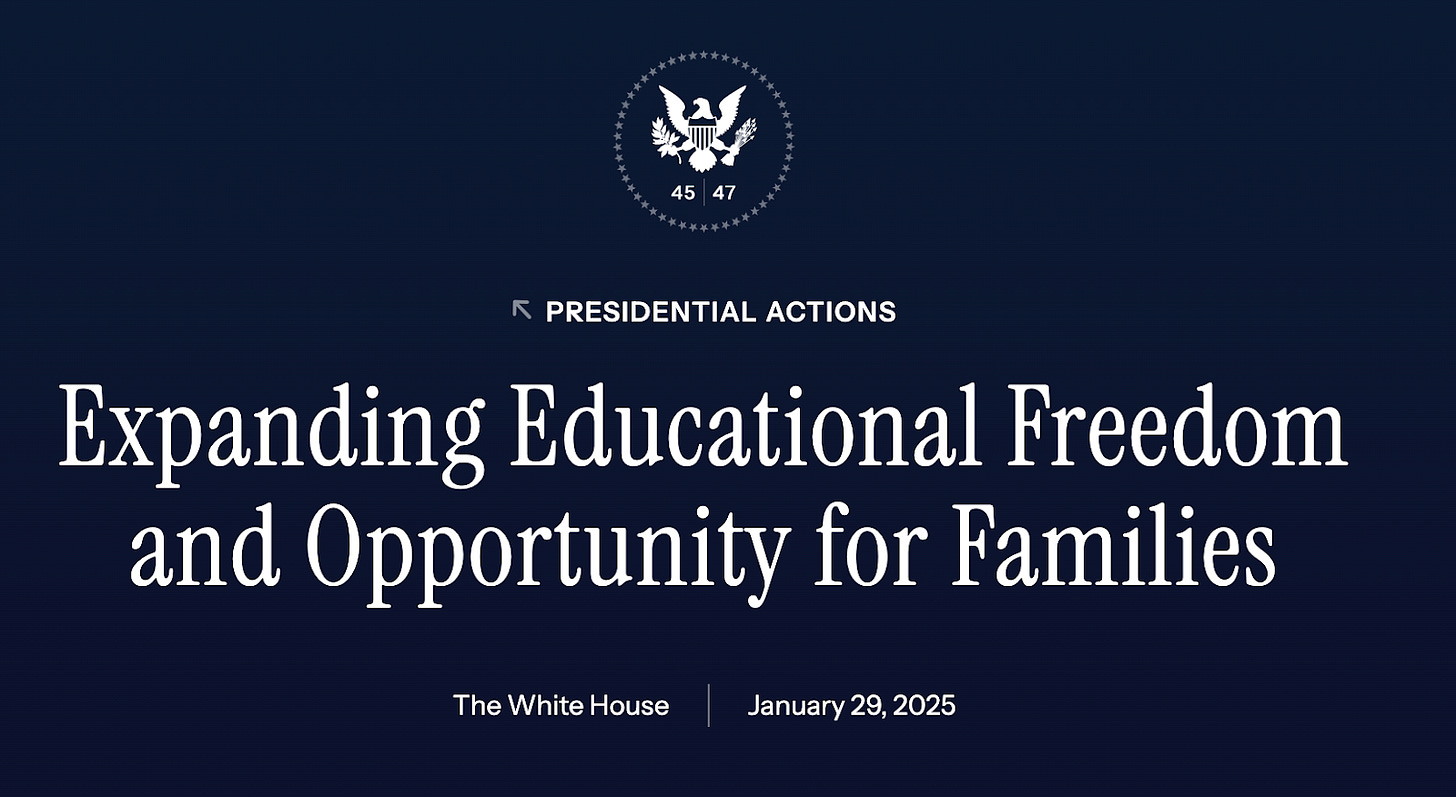Goodbye, First 100 Days
And Hello, Columbus!
What Just Happened?
Three months and a few days isn’t much time to accomplish a lot. But as is typical of any new administration, the White House is taking a victory lap for its actions across a range of issues. Can you blame them? When it comes to education, these first 100 days have been surprisingly active — not just in Washington, but across the entire country. What stands out is the sheer volume of momentum around education opportunity and innovation emerging from every corner of the nation. As many understand, the president’s bully pulpit plays a powerful role in fueling the nation’s political engine.
Some education reformers have complained that the pace is too fast — that President Trump and his team are using a hatchet where a scalpel would do. They acknowledge government is too big but question whether all the cuts were necessary. Maybe, maybe not. But reasonable people who can separate policy from politics have to give credit where it’s due. Many changes align with long-held recommendations from CER, and seeds are being sown for a permanent transformation of education — for the better.
Here are three major initiatives — even those still in the “whisper phase” — that are already causing significant shifts in behavior at every level:
1. School Choice is now a National Priority
For more than three decades the states have driven hard on education opportunity. But it’s not always easy, especially when national political leaders oppose you or prop up factions of special interests who then dominate the prominent forums. Remember that the very first visitors to the Biden White House after inauguration were the heads of the major teachers unions. That “picture” can have a chilling effect in some states on building and otherwise typically bi-partisan movement.
The tides shifted however, this year for everyone. From the January 29th Executive Order encouraging agencies to free up funding to follow students, to the directive to close the Department of Education and return power to the states, to his public, to vocal support for governors leading the charge, the President is backing the more than 75% of parents — across political and socioeconomic lines — who demand education freedom. Parents need solutions as most schools continue to fail more than two-thirds of their students.
In just 100 days, Idaho enacted and Tennessee and Wyoming expanded their choice programs, Texas Gov. Greg Abbott will sign his state’s first school choice program this Saturday, North Dakota finally has charter schools, a religious charter school case in front of the US Supreme Court today is drawing supporters far and near and a federal tax credit program is gaining steam.
Now it’s time for hesitant state leaders to act. Call it your “200 days” — but get it done.
2. Restoring Sanity to Higher Ed Policy
The administration is tackling accreditation, career training, and workforce-aligned learning—with another Executive Order issued just last week, signaling major changes ahead. Reforming how higher education institutions are allowed to exist and operate has long been a priority for education innovators across sectors. Empowering strong, forward-thinking institutions to lead the way is a consistent theme at gatherings like the annual ASU+GSV Summit. This year, it's also a top priority for leaders in both the House and Senate education committees.
The Executive Order is notable in many ways, but one section in particular stands out — a long-overdue acknowledgment of the broken system that accreditation has become in higher education:
“Accreditors routinely approve institutions that are low-quality by the most important measures. The national six-year undergraduate graduation rate was an alarming 64 percent in 2020. Further, many accredited institutions offer undergraduate and graduate programs with a negative return on investment — almost 25 percent of bachelor’s degrees and more than 40 percent of master’s degrees — which may leave students financially worse off and in enormous debt by charging them exorbitant sums for a degree with very modest earnings potential.”
The solution? To start, recognize new accreditors that value innovation and outcomes, give legacy institutions some competition, and drive the creation of programs that are actually relevant to today’s workforce.
Meanwhile in Congress, support is building to expand Pell Grants for short-term credentials, limit how much students can borrow, and shift more financial responsibility to institutions. It’s a start.
3. Innovation and AI in Education
This AI Executive Order casts a bold vision for national advancement and recognizes that to get there:
“...we must also invest in our educators and equip them with the tools and knowledge to not only train students about AI, but also to utilize AI in their classrooms to improve educational outcomes.”
It’s an ambitious, exciting step forward — especially for those of us committed to bridging the opportunity and innovation divide.
China, watch out!
Welcome Back, Christopher Columbus!
“In fourteen hundred and ninety-two, Columbus sailed the ocean blue…”
I’ll never forget that. Memorizing and applying history is a powerful way to learn. Right after we learned that rhyme, my 4th-grade teacher Mrs. Jepsen taught us how to eat spaghetti with chopsticks, as we explored how that “Italian” noodle actually came from the East.
Later, before I fully understood the historical grievances people held (some very valid), I couldn’t grasp the opposition to celebrating Columbus Day. As a first-generation Italian-American, I felt proud that America had a day that recognized our heritage.
Then came the backlash, the rewriting of history, and the political retreat — as Columbus Day was replaced by various alternatives, like Indigenous Peoples Day. Never mind that there are already days and entire months devoted to nearly every other group — except us. And that someone who he indeed did initiate exploration of the world should be highly regarded.
Yes, I’ve read the criticisms of Columbus, and I understand the context. I’ve written about it. But I’m still grateful that a President who owed Italian-Americans nothing helped restore Columbus Day’s rightful place in history.
(Before throwing tomatoes — or showering me with baci — check out this incredible podcast series that dives into Columbus’s life, legacy, and relationship with the Italian-American community, bringing together expert voices from all perspectives.)
This October 13th, 2025, I hope to once again march proudly in one of many Columbus Day events - without the virtue signaling we’ve come to expect!
ICYMI
A woman known for revolutionizing education for students with autism has just been appointed Deputy Assistant Secretary for Special Education and Rehabilitative Services.
Diana Diaz-Harrison is not only a dear friend and champion for families and students with special needs, she’s also the founder of Arizona Autism Charter Schools and its associated Accelerator — an effort to bring her model to every major U.S. city.
Learn more about Diana’s work and her journey on this week’s EdReform in 10 Flash podcast (along with her thoughts on RFK Jr.’s recent comments about people with autism) hosted by our Dash Media partner and GSV founder Michael Moe following a visit to the school’s flagship campus in Phoenix from U.S. Education Secretary Linda McMahon — soon to be Diana’s new boss — in honor of Autism Awareness Month. The media presence was huge, and helped amplify the reality that every child can learn when we leverage the best science on their behalf.
We share Diana’s passion for these students and her commitment to ensuring that no school or public official ever underestimates their ability to succeed.
And with that, I’m off. Until next week - Jeanne





